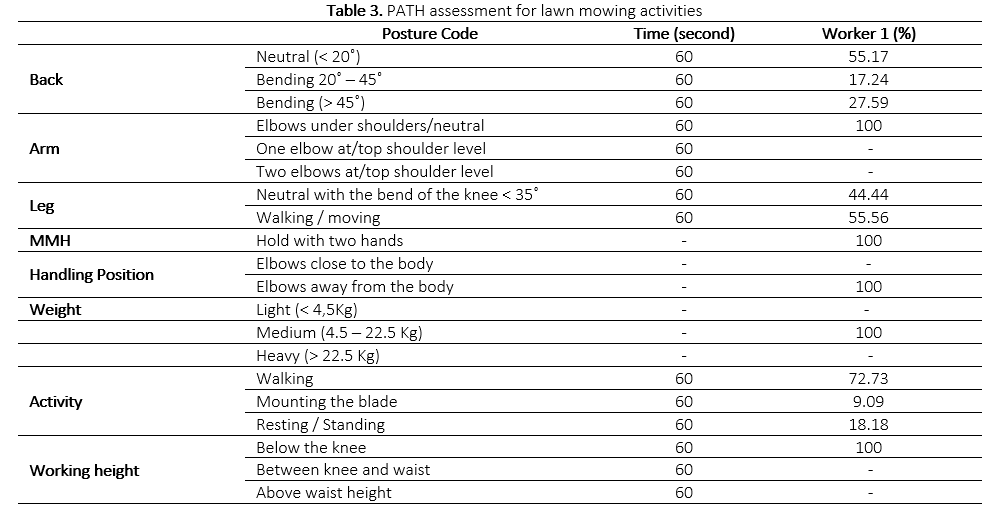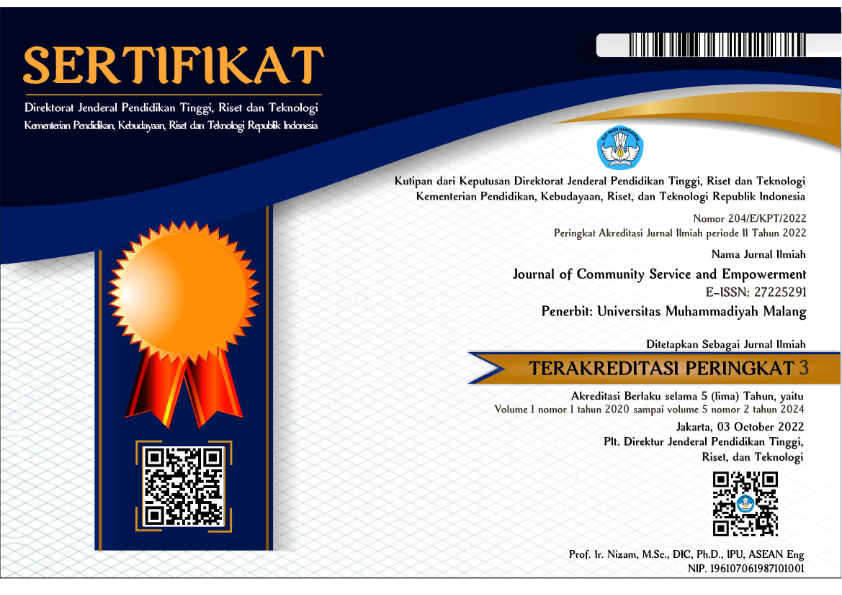Checkpoint ergonomics as a health and safety effort at work among women farmers
DOI:
https://doi.org/10.22219/jcse.v4i3.26264Keywords:
Ergonomics, Checkpoint Ergonomics, PATH, Women Farmers, Health and safetyAbstract
PT X is a company that works in the plantation sector, one of which is an orange plantation. In the process of harvesting lime leaves, there are 3 workstations and 4 work activities. Most of the work is done manually with a high workload and repetitive movements, causing musculoskeletal complaints. Workers complain of musculoskeletal disorders while working. During initial observation, there were complaints of pain in the neck, shoulders, arms, waist, thighs, and knees. Based on these problems, this study aims to analyze the factors that cause musculoskeletal disorders in the orange harvesting process. The method used to solve problems with partners is by using an ergonomic checklist and the PATH method to analyze three physical risk factors in the workplace. Based on the results of data processing using the PATH method, it was found that the biggest risk factors for injury were 45.53% soil hoeing, 42.39% harvesting and 12.08% grass cutting. The proposed improvements given after being analyzed using ergonomic checkpoints are: (1) reducing bending or squatting postures; and (2) providing protectors and covers for lawn mowers and handcarts and handles for tools for harvesting oranges. This proposed improvement is in accordance with Sustainable Development Goals number 3, namely Good Health and Wellbeing for all.
Downloads
References
Abdollahpour, N., & Helali, F. (2022). Implementing practical ergonomics knowledge transfer using ergonomic checkpoints to support the participatory ergonomics process in an Industrially Developing country. IISE Transactions on Occupational Ergonomics and Human Factors, 10(2), 59–70.
Ahmadi, M., Zakerian, S. A., & Salmanzadeh, H. (2017). Prioritizing the ILO/IEA Ergonomic Checkpoints’ measures; a study in an assembly and packaging industry. International Journal of Industrial Ergonomics, 59, 54–63.
Arabian, A., Omidi, L., Bakhshi, E., Ghanbari, A., Torabinassaj, E., & Zakerian, S. A. (2020). Assessment of occupational safety, health, and ergonomics issues in agriculture in some cities of Iran. Work, 65, 89–96. https://doi.org/10.3233/WOR-193061
Arifin, A. N., Rahayu, S. R., & Rustiana, E. R. (2020). Analysis of Postures Towards Musculoskeletal Disorders Experienced By Batik Artisans of Sukamaju Giriloyo Yogyakarta. Public Health Perspective Journal, 5(1).
Beheshti, M. H., Javan, Z., & Yarahmadi, G. (2016). Ergonomic evaluation of musculoskeletal disorders in construction workers using posture, activity, tools, handling (PATH) method. International Journal of Occupational Hygiene, 8(2), 110–115.
Besharati, A., Daneshmandi, H., Zareh, K., Fakherpour, A., & Zoaktafi, M. (2020). Work-related musculoskeletal problems and associated factors among office workers. International Journal of Occupational Safety and Ergonomics : JOSE, 26(3), 632–638. https://doi.org/10.1080/10803548.2018.1501238
Buchholz, B., Paquet, V., Punnett, L., Lee, D., & Moir, S. (1996). PATH: A work sampling-based approach to ergonomic job analysis for construction and other non-repetitive work. Applied Ergonomics, 27(3), 177–187.
Caple, D. C. (2010). The IEA contribution to the transition of Ergonomics from research to practice. Applied Ergonomics, 41(6), 731–737. https://doi.org/https://doi.org/10.1016/j.apergo.2010.03.002
Charles, L. E., Ma, C. C., Burchfiel, C. M., & Dong, R. G. (2018). Vibration and Ergonomic Exposures Associated With Musculoskeletal Disorders of the Shoulder and Neck. Safety and Health at Work, 9(2), 125–132. https://doi.org/10.1016/j.shaw.2017.10.003
El-Shafie, H. A. F. (2019). Insect Pest Management in Organic Farming System. In J. Moudrý, K. F. Mendes, J. Bernas, R. da Silva Teixeira, & R. N. de Sousa (Eds.), Multifunctionality and Impacts of Organic and Conventional Agriculture. IntechOpen. https://doi.org/10.5772/intechopen.84483
Fulmer, S., Jenkins, P., Mason, C., Bresee, C., & May, J. (2004). Ergonomic analysis of New York apple harvest work using a Posture-Activities-Tools-Handling (PATH) work sampling approach. Journal of Agricultural Safety and Health, 10(3), 163.
Gonzalez, I., & Morer, P. (2016). Ergonomics for the inclusion of older workers in the knowledge workforce and a guidance tool for designers. Applied Ergonomics, 53, 131–142. https://doi.org/https://doi.org/10.1016/j.apergo.2015.09.002
Hajaghazadeh, M., Mohammadian, Y., Normohammadi, M., & Zare, M. (2012). An ergonomic study in building demolition: Assessment of musculoskeletal disorders risk factors by PATH method. International Journal of Environmental Health Engineering, 1(1), 43.
Helali, F. (2009). Using ergonomics checkpoints to support a participatory ergonomics intervention in an industrially developing country (IDC)-a case study. International Journal of Occupational Safety and Ergonomics, 15(3), 325–337.
Kawakami, T., & Kogi, K. (2005). Ergonomics support for local initiative in improving safety and health at work: International Labour Organization experiences in industrially developing countries. Ergonomics, 48(5), 581–590.
Kochańska, J., Burduk, A., Markowski, M., Kłusek, A., & Wojciechowska, M. (2023). Improvement of Factory Transport Efficiency with Use of WiFi-Based Technique for Monitoring Industrial Vehicles. Sustainability, 15(2). https://doi.org/10.3390/su15021113
Kogi, K., Sano, Y., Yoshikawa, T., & Yoshikawa, S. (2019). The design and use of ergonomic checkpoints for health care work. Proceedings of the 20th Congress of the International Ergonomics Association (IEA 2018) Volume I: Healthcare Ergonomics 20, 520–527.
Kong, Y.-K., Lee, S., Lee, K.-S., & Kim, D.-M. (2018). Comparisons of ergonomic evaluation tools (ALLA, RULA, REBA and OWAS) for farm work. International Journal of Occupational Safety and Ergonomics, 24(2), 218–223. https://doi.org/10.1080/10803548.2017.1306960
Kucera, K. L., & Lipscomb, H. J. (2010). Assessment of physical risk factors for the shoulder using the posture, activity, tools, and handling (PATH) method in small-scale commercial crab pot fishing. Journal of Agromedicine, 15(4), 394–404.
Nag, P. K., & Gite, L. P. (2020). Ergonomics Application in Design of Farm Tools and Equipment BT - Human-Centered Agriculture : Ergonomics and Human Factors Applied (P. K. Nag & L. P. Gite (eds.); pp. 301–331). Springer Singapore. https://doi.org/10.1007/978-981-15-7269-2_12
Niu, S. (2010). Ergonomics and occupational safety and health: An ILO perspective. Applied Ergonomics, 41(6), 744–753.
Niu, S., & Kogi, K. (2012). Ergonomic checkpoints in agriculture. Geneva (Switzerland): International Labour Office, 234.
Paquet, V., Punnett, L., & Buchholz, B. (1999). An evaluation of manual materials handling in highway construction work. International Journal of Industrial Ergonomics, 24(4), 431–444.
Parvez, M. S., & Shahriar, M. M. (2018). Agricultural Farm-Related Injuries in Bangladesh and Convenient Design of Working Hand Tools. Journal of Healthcare Engineering, 2018, 4273616. https://doi.org/10.1155/2018/4273616
Pérez, E., Rodríguez, Y., Salazar, M. C., & Trujillo, M. A. (2021). Improving working conditions using the ergonomic checkpoints tool: Application in a Colombian meat processing plant. IISE Transactions on Occupational Ergonomics and Human Factors, 9(2), 72–77.
Piligian, G., Herbert, R., Hearns, M., Dropkin, J., Landsbergis, P., & Cherniack, M. (2000). Evaluation and management of chronic work‐related musculoskeletal disorders of the distal upper extremity. American Journal of Industrial Medicine, 37(1), 75–93.
Purwanto, W. (2013). Perancangan Cangkul Ergonomis untuk Meningkatkan Kapasitas Kerja Petani dalam Mengolah Tanah Sawah. agriTECH, 12(3), 24-32.
Rahman, C. (2014). Study and Analysis of Work Postures of Workers working in a Ceramic Industry through Rapid Upper Limb Assessment (RULA). International Journal of Engineering and Applied Sciences 2305-8269, 5, 14–20.
Restuputri, D. P., Achmad, R. U., Lukman, M., & Masudin, I. (2021). Analysis of Work Posture Using the Muscle Fatigue Assessment (MFA) and Novel Ergonomic Postural Assessment (NERPA). Jurnal Ilmiah Teknik Industri, 20(1), 9–20.
Ridley, J. R., & Pearce, D. (2006). Safety with machinery. Elsevier.
Spielholz, P., Silverstein, B., Morgan, M., Checkoway, H., & Kaufman, J. (2001). Comparison of self-report, video observation and direct measurement methods for upper extremity musculoskeletal disorder physical risk factors. Ergonomics, 44(6), 588–613.
Torghabeh, Z. J., Buchholz, B., & Stentz, T. L. (2020). Assessment of physical risk factors using the posture, activity, tools, and handling (path) method in construction glass and glazing work. International Journal of Advances in Engineering & Technology, 13(3), 80–93.
Widyanti, A. (2018). Ergonomic checkpoint in agriculture, postural analysis, and prevalence of work musculoskeletal symptoms among Indonesian farmers: road to safety and health in agriculture. Jurnal Teknik Industri, 20(1), 1–10.

Downloads
Published
How to Cite
Issue
Section
License
Copyright (c) 2023 Dian Palupi Restuputri, Ilyas Masudin, Rahmad Wisnu Wardhana, Teguh Baroto, Arisna Arbiatul

This work is licensed under a Creative Commons Attribution-ShareAlike 4.0 International License.












